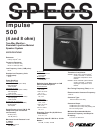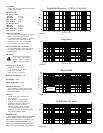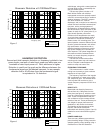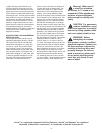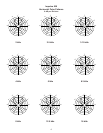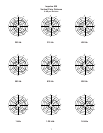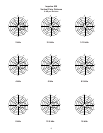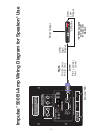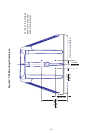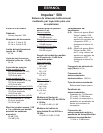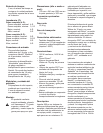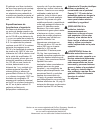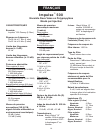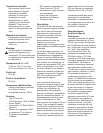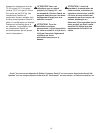
zoidal shape, along with a coated perforat-
ed metal grille to offer a cosmetically ele-
gant yet durable system.
The two-way system includes a 15"
Black Widow woofer with a Kevlar
¨
impregnated cone and a specially treated
surround, cone and dust cap for excellent
weather resistance. The 22XT compres-
sion driver features a 2" titanium
diaphragm, and is coupled to an extremely
smooth and well controlled constant direc-
tivity horn, with a coverage pattern of
90 degrees by 45 degrees that is molded
into the enclosure. Input connection to the
system is made via 1/4" phone jacks (2) or
4-pin Neutrik Speakon connectors.
Provisions for bi-amplification are made
via a lock-down switch selected mode of
operation for the Neutrik connectors, or
instant access 1/4" switching jacks. The
internal passive crossover features Sound
Guard to protect the tweeter, and utilizes
high performance components and an
advanced topology crossover to provide
high power handling and a smooth yet
clear response. The optimal integration of
the crossover with the selected drivers
results in a smooth frequency response
from 62 Hz to 18 kHz.
The free-flow vented cabinet offers
mounting point inserts top and bottom as
well as a molded-in stand adapter for
maximum utility and ease of use.
FREQUENCY RESPONSE:
This measurement is useful in deter-
mining how accurately a given enclosure
reproduces an input signal.
The frequency response of the Impulse
500 is measured at 1 meter using a 2.82-
volt, swept-sine input. The selected driver
in the Impulse 500 combine to give a
smooth frequency response from 62 Hz to
18 kHz.
DIRECTIVITY:
Beamwidth and directivity factors are
derived from the -6 dB points from the
polar plots (see figure 3), which are mea-
sured in a whole space anechoic environ-
ment. These are specifications that pro-
vide a reference to the coverage charac-
teristics of the unit. These parameters pro-
vide insight for proper placement and
installation in the chosen environment.
The blending of the components of the
Impulse
ª
500 exhibit a desirable
beamwidth and directivity (figures 3 and 4)
suitable for sound reinforcement applica-
tions.
POWER HANDLING:
There are many different approaches to
power handling ratings. Peavey rates this
speaker systemÕs power handling using a
modified form of the AES Standard
3
20 50 100 200 500 1k 2k 5k 10k 20k
Frequency (Hz)
50
60
70
80
90
100
110
120
dB SPL (re 20 Pa)
Harmonic Distortion at 1/10 Rated Power
Figure 6
3rd Harmonic
2nd Harmonic
20 50 100 200 500 1k 2k 5k 10k 20k
Frequency (Hz)
40
50
60
70
80
90
100
110
dB SPL (re 20 Pa)
Harmonic Distortion at 1/100 Rated Power
Figure 5
3rd Harmonic
2nd Harmonic
HARMONIC DISTORTION
Second and third harmonic distortion vs. frequency is plotted in two
power levels: one tenth of rated input power and either one one
hundredth of rated input power or 1 Watt, whichever is higher.
Distortion is read from the graph as the difference between the
fundamental signal and the desired harmonic. As an example,
distortion that is 40 dB down from the fundamental signal
is equivalent to 1% distortion.



